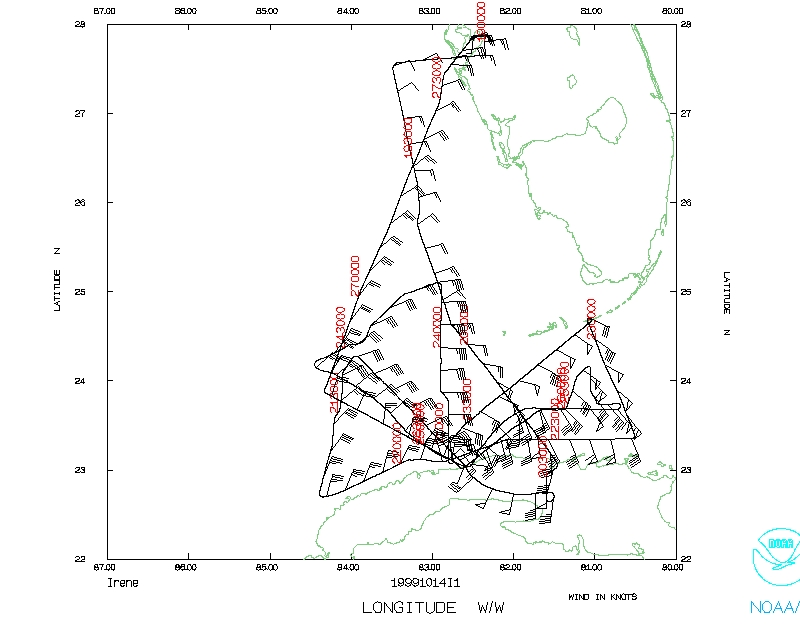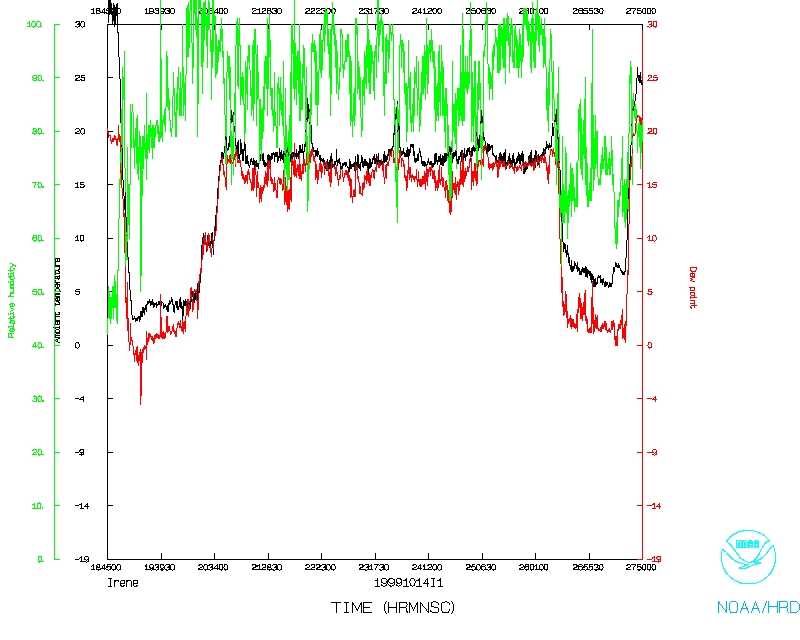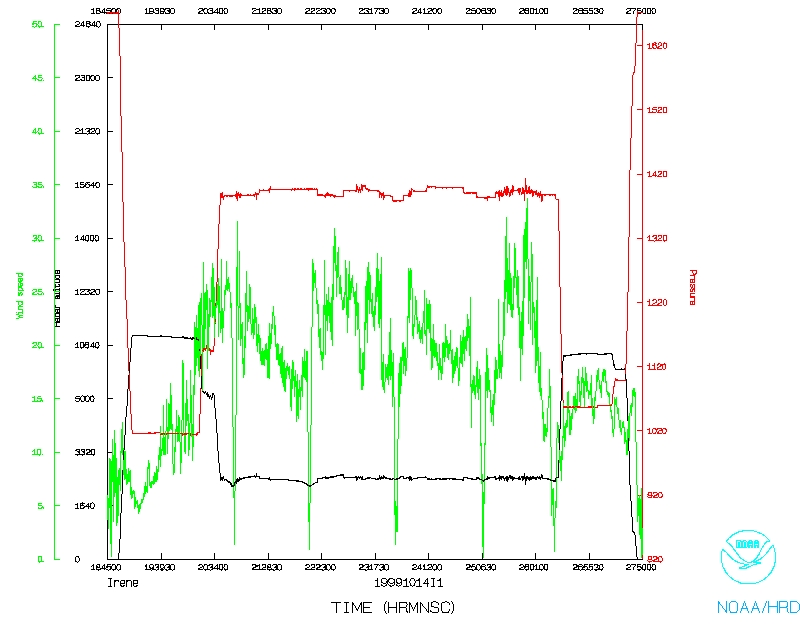 Flight track |
 Temperature and Moisture |
 Wind and Atlitude |
| Lead Scientist | J. Cione |
| AXBT Scientist | J. Cione |
| GPS Scientist | M. Black |
| Radar Scientist | P. Dodge |
Mission Briefing:
This flight was an NHC-tasked reconnaissance mission into Hurricane Irene. Such missions are routinely required when Tropical Cyclones (TC) move in close proximity to Cuba. Under these conditions, the Air Force Reserves cannot conduct TC reconnaissance missions. During the 9910141 mission we also made a conscious effort to obtain ocean thermal structure out ahead of the TC (predominantly to the north and east of the system) while still furfilling our flight requirements of 2 IZ, OOZ and 03Z center fixes. In addition to the AXBT drops we also deployed several GPS sondes in and around areas of active convection throughout flight 9910141.
Mission Synopsis
| Take off | Landing
| MacDill AFB, FL | 18:56 UTC
| MacDill AFB, FL | 03:42 UTC
| | ||
The flight departed MacDill AFB at 1856 UTC on 10/14 and landed there at 0355 UTC, on 10/15 for a duration of 9 hours. The flight pattern (Fig. 1) consisted of a direct path to the Dry Tortugas C-MAN site (24.40°N 81.50°W). From there we headed SE to the IP (23.33°N 80.50°W). Along that leg 5 AXBTs were deployed within the relatively deep waters of the Loop Current north of Cuba. For 3 of the 5 AXBTs launched, concurrent atmospheric soundings from GPS sondes were obtained. 4/5 of the AXBTs were successful. Unfortunately the one failure was launch number one which was with a GPS comparison at the Dry Tortugas C-MAN site. After this leg we headed SW for the 21Z fix which ended up being located only a couple miles SW of Havana. The OOZ and 03Z fixes were located just off shore and north of Havana. Due to the location of the center of circulation we alternated between 105 mi. coastal patrol legs (i.e. E-W legs along northern Cuba coastline) and 'half pie slice' radial legs away from the center (Fig. 1). After our 03Z fix we headed out north and west of the circulation center 24°N 84.3°W. At this location we were in deeper water associated with the loop current and as such, deployed 4 AXBTs along our flight back to MacDill.
Evaluation:
A total of 11 AXBTs, were deployed. Of these 11, SST was recorded for 10 drops (i.e. a 91% success rate). SST measurements ranged from 27.7°-29.0°C. Of the 11 drops MLDs were obtained from only 6 AXBTs (i.e. a 55% success rate). MLDs ranged from 40 - 67m. We also launched 15 GPS dropwindsondes during flight 9910141 (Table 1). For 4 ofthese GPS sondes we obtained thermal ocean structure from 4 concurrent AXBT launches. Of the 15 GPS sondes deployed, 7 measured a lOm surface wind. The maximum surface wind observed by GPS for this flight was 46kts within the west wind maxima ~20 miles north and west of the center (SFMR reported maximum surface winds ~60kts). Minimum surface pressure extrapolated from 5k ft was 988mb at 21Z. Doppler and C-band radar systems in addition to SFMR were used throughout the mission.
Problems: There were several minor/moderate problems associated with this mission. The AXBT signal strength was noticeably weak especially when we were above lOk ft and in precipitation (inbound and outbound legs). [This problem was caused by the lack of a signal amplifier which was not installed on N43RF-FDA] Also SFMR winds illustrated a consistent 'high bias' when compared with the GPS surface winds. This may or may not have something to do with the presence of a rapidly moving loop current in this region. (It is also possible that other issues may be at play.) This problem/inconsistency should be given high priority given the obvious operational potential of SFMR. Another area of concern is with the continual/habitual failure of the GPS sondes in obtaining near-surface winds (i.e. 8/15 - a 53% failure rate). This season the GPS sondes have often not been able to obtain the average boundary layer winds and/or lOm surface winds. It is possible that a dialogue with Vaisala may be necessary. Finally, both radar systems worked without any major problems throughout the mission.
Joe Cione
10/19/99
Mission data:
 Flight track |
 Temperature and Moisture |
 Wind and Atlitude |